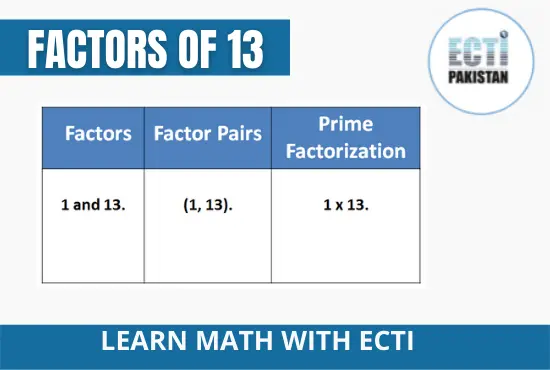Factors of 13 – Prime Factorization | Easy Method

Contents
Factors of 13
Factors of 13 are numbers that divide the number 13 completely without leaving any residue.
There can be positive and negative factors for 13, but they cannot be decimals or fractions.
For example:
The pair factors of 13 can be (1, 13) or (-1, -13). We can multiply the negative pair factors to get the original number. Therefore, multiplying -1 by -13 results in 13.
In this article, we will learn how to use the division method and prime factorization method to calculate the factors of 13 and pair factors.
What are the Factors of 13?
Factors of 13 are the numbers multiplied in pairs to give the original number 13. Therefore, the factors of 13 are the numbers that divide 13 without leaving a remainder. Since 13 is a prime number, it has only two factors, one and the number itself. Therefore, it has two factors, 1 and 13.

| Factors of 13: 1 and 13Prime Factorization of 13: 1 x 13 |
What are the Factors of -13?
When we multiply two numbers and get -13 as a product, those numbers are the factors of -13. Here is the explanation:
-1 × 13 = -13
1 × -13 = -13
We can get -13 by having (-1, 13) as a pair of factors. Similarly, we can also get -13 by having (1, -13)as a pair of factors.
Pair Factors of 13
When two numbers are multiplied, they give the product value of 13. The pair factor 13 can be both a positive and a negative factor. The number 13 has a single pair factor because it is a prime number.
Accordingly, it has the following positive pair factor:
| Positive Factors of 13 | Positive Pair Factors of 13 |
| 1 × 13 | (1, 13) |
Similarly, the negative pair factor of 13 is given below:
| Negative Factors of 13 | Negative Pair Factors of 13 |
| -1 × -13 | (-1,-13) |
Factors of 13 by Division Method
In order to find the factors of 13, one of the methods is to divide. We need to find the number that divides 13 exactly without leaving any remainder using this division method. Let’s first divide 13 by 1, and then divide the number by the consecutive integers.
13/1 = 13 (Remainder is 0 and the factor is 1)
13/13 = 1 (Remainder is 0 and the factor is 13)
When we divide 13 by numbers other than 1 and 13, we are left with a remainder. Therefore, factors 13 are 1 and 13.
More factors
Factors of 42= 1, 2, 3, 6, 7, 14, 21, and 42.
Factors of 48= 1, 2, 3, 4, 6, 8, 12, 16, 24, and 48.
Factors of 64= 1, 2, 4, 8, 16, 32, 64.
Factors of 96= 1, 2, 3, 4, 6, 8, 12, 16, 24, 32, 48 and 96.
Prime Factorization of 13
Prime factorization is the process of expressing a number as the product of its prime factors.

Here is the prime factorization of 13:
Step 1:
Write down the pair factor of 13, let’s say (1, 13)
Step 2:
The numbers 1 and 13 are both prime numbers, which cannot be further divided. To write down the factors, multiply 1 by 13.
As a result, 13 is equal to 1 × 13
Therefore, the prime factorization of 13 is 1 x 13 or 131.
Solved Examples
Example 1:
Find out the common factors of 13 and 72.
Solution:
Factors 13 are 1 and 13
Factors of 72= 1, 2, 3, 4, 6, 8, 9, 12, 18, 24, 36, and 72.
Thus, the common factor of 13 and 72 is 1.
Example 2:
Calculate the common factors of 75 and 14.
Solution:
Factors of 75 are 1, 3, 5, 15, 25, and 75.
Factors of 14= 1, 2, 7, and 14.
Therefore, the common factor of 75 and 14 is 1.
Example 3:
Calculate the common factors of 13 and 24.
Solution:
The factors 13 = 1 and 13
Factors of 24= 1, 2, 3, 4, 6, 8, 12, and 24.
Therefore, the common factor of 13 and 24 is 1.
| Links Related to Factors | |
| Factors of 24= 1, 2, 3, 4, 6, 8, 12, and 24. | Factors of 36= 1, 2, 3, 4, 6, 9, 12, 18, and 36. |
| Factors of 48= 1, 2, 3, 4, 6, 8, 12, 16, 24, and 48. | Factors of 14= 1, 2, 7, and 14. |
| Factors of 42= 1, 2, 3, 6, 7, 14, 21, and 42. | Factors of 60= 1, 2, 3, 4, 5, 6, 10, 12, 15, 20, 30 and 60. |
| Factors of 35= 1, 5, 7, and 35. | Factors of 72= 1, 2, 3, 4, 6, 8, 9, 12, 18, 24, 36 and 72. |
| Factors of 84= 1, 2, 3, 4, 6, 7, 12, 14, 21, 28, 42 and 84. | Factors of 50= 1, 2, 5, 10, 25, 50. |
FAQ’s
What are the factors of 13?
Since 13 is a prime number, its factors are 1 and 13.
What is the prime factorization of 13?
Prime factorization of 13 =1 × 13 or 131.
How many factors does the number 13 have?
There are only two factors in the number 13: 1 and the number itself (i.e. 1 and 13).
What are the positive and negative pair factors of 13?
Pair factors (1, 13) and (-1, -13) are the positive and negative values of 13.
Is 3 a factor of 13?
No, 3 is not a factor of 13. As 13 is a prime number, 1 and the number itself are the factors of 13.
